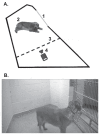Effects of acepromazine or methadone on midazolam-induced behavioral reactions in dogs
- PMID: 25183896
- PMCID: PMC4137930
Effects of acepromazine or methadone on midazolam-induced behavioral reactions in dogs
Abstract
This study evaluated whether acepromazine or methadone reduced behavioral parameters, overall excitement, and activity associated with midazolam administration to healthy dogs. Dogs received midazolam (M) alone [M: 0.25 mg/kg body weight (BW)] or with methadone (MM) (MM: 0.75 mg/kg BW) or acepromazine (MA) (MA: 0.03 mg/kg BW) or saline (S) solution alone, all intramuscularly. Two blinded observers evaluated behavioral parameters using video recordings 30 min before and after injection of drugs. Accelerometery was used to evaluate "total activity counts" (TAC) at baseline and post-treatment. Post-treatment excitement scores were significantly higher in M and MA compared to baseline, M and MM compared to S, and M compared to MA. Behavioral parameters showed significantly higher proportions of "pacing" post-treatment in all groups receiving midazolam, and "restlessness," "chewing/licking," and "sniffing" in M. No significant differences were found for TAC at baseline and post-treatment. Midazolam-induced paradoxical behavioral changes (excitation, panting, pacing, restlessness, licking/chewing, and vocalization) were not prevented by acepromazine or methadone in healthy dogs.
Effets de l’acépromazine ou de la méthadone sur les réactions comportementales induites par le midazolam chez les chiens. Cette étude a évalué si l’acépromazine ou la méthadone réduisait les paramètres comportementaux, le niveau d’excitation général et l’activité associée à l’administration de midazolam chez des chiens en santé. Les chiens ont reçu le midazolam (M) seul (M : 0,25 mg/kg poids corporel [PC]) ou avec de la méthadone (MM) (MM : 0,75 mg/kg PC) ou de l’acépromazine (MA) (MA : 0,03 mg/kg PC) ou une solution saline (S) seule, tous administrés par voie intramusculaire. Deux observateurs à l’aveugle ont évalué les paramètres comportementaux à l’aide d’enregistrements vidéo 30 minutes avant et après l’injection des médicaments. Un accéléromètre a été utilisé pour évaluer les «numérations de l’activité totale» (NAT) comme données de référence et après le traitement. Les notes d’excitation après le traitement étaient significativement supérieures pour M et MA comparativement aux données de référence, M et MM comparativement à S et M comparativement à MA. Les paramètres comportementaux ont montré des proportions significativement supérieures de «va-et-vient» après le traitement dans tous les groupes qui avaient reçu midazolam et une «agitation», de «mastication et léchage» et de «reniflement» dans M. Aucune différence significative n’a été constatée pour NAT aux données de référence et après le traitement. Les changements comportementaux paradoxes induits par le midazolam (excitation, halètement, va-et-vient, agitation, lèchage et mastication et vocalisation) n’ont pas été prévenus par l’acépromazine ni la méthadone chez les chiens en santé.(Traduit par Isabelle Vallières).
Figures








Similar articles
-
Effects of methadone, alone or in combination with acepromazine or xylazine, on sedation and physiologic values in dogs.Vet Anaesth Analg. 2008 Nov;35(6):519-27. doi: 10.1111/j.1467-2995.2008.00412.x. Epub 2008 Jun 19. Vet Anaesth Analg. 2008. PMID: 18565203 Clinical Trial.
-
The sedative and behavioral effects of nalbuphine in dogs.Contemp Top Lab Anim Sci. 2003 Jul;42(4):27-31. Contemp Top Lab Anim Sci. 2003. PMID: 12906398
-
Cardiovascular effects of a proprietary l-methadone/fenpipramide combination (Polamivet) alone and in addition to acepromazine in healthy Beagle dogs.Vet Anaesth Analg. 2012 Sep;39(5):451-63. doi: 10.1111/j.1467-2995.2012.00757.x. Epub 2012 Jul 13. Vet Anaesth Analg. 2012. PMID: 22788416 Clinical Trial.
-
Tramadol does not enhance sedation induced by acepromazine in dogs.Can J Vet Res. 2016 Oct;80(4):323-328. Can J Vet Res. 2016. PMID: 27733788 Free PMC article. Clinical Trial.
-
Effects of medetomidine-midazolam, acepromazine-butorphanol, and midazolam-butorphanol on induction dose of thiopental and propofol and on cardiopulmonary changes in dogs.Am J Vet Res. 2002 Dec;63(12):1671-9. doi: 10.2460/ajvr.2002.63.1671. Am J Vet Res. 2002. PMID: 12492281
Cited by
-
Comparison of the sedative effects of alfaxalone and methadone with or without midazolam in dogs.Can Vet J. 2019 Oct;60(10):1060-1064. Can Vet J. 2019. PMID: 31597990 Free PMC article.
-
Dexmedetomidine to control signs associated with lisdexamfetamine dimesylate toxidrome in a cat.Can Vet J. 2017 Mar;58(3):261-264. Can Vet J. 2017. PMID: 28246413 Free PMC article.
-
The pharmacokinetics and pharmacodynamics of midazolam after intravenous administration to donkeys (Equus africanus asinus).Can J Vet Res. 2022 Apr;86(2):125-131. Can J Vet Res. 2022. PMID: 35388227 Free PMC article.
-
Sedation Efficacy of Midazolam in Conjunction with Ketamine and Alfaxalone in Female Laboratory Guinea Pigs (Cavia porcellus).J Am Assoc Lab Anim Sci. 2024 Jul 29;63(5):572-80. doi: 10.30802/AALAS-JAALAS-24-000028. Online ahead of print. J Am Assoc Lab Anim Sci. 2024. PMID: 39074958 Free PMC article.
References
-
- Simiand J, Keane PE, Biziere K, Soubrie P. Comparative study in mice of tetrazepam and other centrally active skeletal muscle relaxants. Arch Int Pharmacodyn Ther. 1989;297:272–285. - PubMed
-
- Dretchen K, Ghoneim M, Long J. The interaction of diazepam with myoneural blocking agents. Anesthesiology. 1971;34:463–468. - PubMed
-
- Quandt J. Analagesia, anesthesia, and chemical restraint in the emergent small animal patient. Vet Clin North Am Small Anim Pract. 2013;43:941–953. - PubMed
-
- Dyson DH. Analgesia and chemical restraint for the emergent veterinary patient. Vet Clin North Am Small Anim Pract. 2008;38:1329–1352. - PubMed
-
- Grandy JL, Dunlop CI. Anesthesia of pups and kittens. J Am Vet Med Assoc. 1991;198:1244–1249. - PubMed
Publication types
MeSH terms
Substances
Grants and funding
LinkOut - more resources
Full Text Sources
